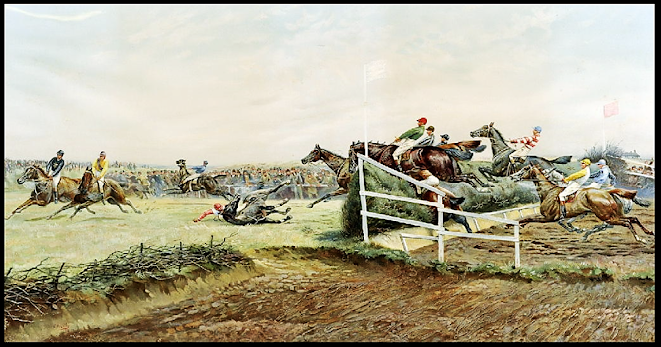THE GRAND NATIONAL 1892 - CANAL TURN
by Godfrey Douglas Giles (1857 - 1941
Researched, written and illustrated by George W. Randall co-founder in July 1996, former Vice Chairman Kinloch Castle Friends' Association.
The picture is displayed in the former Manager's Flat at Kinloch Castle,
originally Sir George Bullough's private quarters.
The Grand National Course at Aintree, near Liverpool,
comprises two circuits,
over thirty jumps covering a distance of 4 miles 856
yards.
The first race took place in 1836 when four horses ran, two finished, the winner being ‘The
Duke’ ridden by Captain Martin Beecher and owned by Mr. Sirdefield,
landlord of The George Inn, at nearby Great Crosby.
Godfrey Douglas Giles’ painting depicts the
1892 National, in which twenty-five horses ran. The winner, in 9 minutes 48.2 seconds was
‘Father O’Flynn’,
ridden by Captain E. Roddy Owen and owned by Colonel Gordon Wilson,
a
dashing young officer in the Household Cavalry who had attracted the attention of
Queen
Victoria when he ran out to stop an attempt on her Majesty’s life.
This painting is
displayed in the Manager’s Quarters at Kinloch Castle. It was recorded by Auctioneers and Valuers
Phillips of Scotland in their
1996 Inventory of Contents as follows:
“Coloured print ‘Steeplechase’
in an ebonised frame. Value £50.”

Captain Owen was in his mid-thirties when
he rode seven-year-old
‘Father O’Flynn’ to victory in the 1892 Grand National.
(Photograph above).
Roddy Owen had come close to victory in
1891, when, riding ‘Cloister,’
he finished second in a “thrilling
race” to ‘Come Away’
ridden by Mr. H. Beasley, an objection by Owen for jostling being
overruled.
‘Cloister’ was a high-class horse
and with
this performance became favourite for the 1892 National.
It was therefore a big disappointment to
Owen not to be the mount chosen by
Arthur Yates, ‘Cloister’s’ trainer.
Despite this, 1892 was to be Captain
Owens’ year, as he raced ‘Father O’Flynn’
home, carrying 12 stone* 7-lbs., (One Stone equals 14-lbs. ),
to win easily
from ‘Cloister,’ ridden by Mr. J. C. Dormer,
followed by A. Nightingall on ‘Ilex’ and G. Williamson
on ‘Ardcarn.’
‘Father O’Flynn’ was born in 1885 by
‘Retreat’ by the renowned ‘Hermit.’
He was only a small horse, standing barely 15.3 hands.
Initially
owned by Lord Cholmondeley,
he had proved of little worth on the flat and was sold after his only
win,
a Two-Year-Old Selling Race at Aintree.
But ‘Father O’Flynn’ was to have his day.
He
went on not only to win the 1893
Grand National, but to do it in record time, 9 minutes
32.4 seconds
from a field of fifteen runners.
THE ARTIST - GODFREY DOUGLAS GILES.
Godfrey Douglas Giles was born in
Karachi on the 9th of November 1857,
at the time under the rule of
the British East India Company, and today, Pakistan.
His father was a captain
in the British Royal Navy based at Karachi.
As a boy Godfrey attended
Cheltenham College, a boarding school founded in 1841
“to educate the sons of
gentlemen”, its curriculum based on “classical, military
and sporting traditions.”
In 1875, after attending the Royal Military College, Sandhurst, in
order to
“launch his military career”, he was posted, aged barely eighteen, to India where
he saw action in the Second Afghan War with the 1st Sind
Horse and 19th Native
Infantry, seeing action in the Battle of
Maiwand in July 1880. He painted a scene
from the one day engagement which was exhibited in 1893.
He later served in Egypt – the General Gordon Relief
Expedition - and South Africa,
retiring as a Major in 1884.
Giles
studied painting at the Paris studio of Carolus Duran, born in Lille, France,
in 1837. Working in oils, watercolour and pastels he painted hunting and racing
scenes in addition to battle panoramas.
His racing pictures are noted for
depicting “the inelegant full-stretch gallop”
of the horses. Giles supplied
illustrations to Black and White, Vanity Fair and Badminton Library,
and in the Boer War (1899-1902) he served as war
correspondent and illustrator for
The
Graphic and Daily Graphic.
His
work was exhibited at Royal Academy and the Paris Salon in 1885.
After
years of living in London and Newmarket, in retirement he settled in Scotland
and died in Edinburgh in February 1941 aged eighty-three.
Reviewed 30 June 2025.






No comments:
Post a Comment